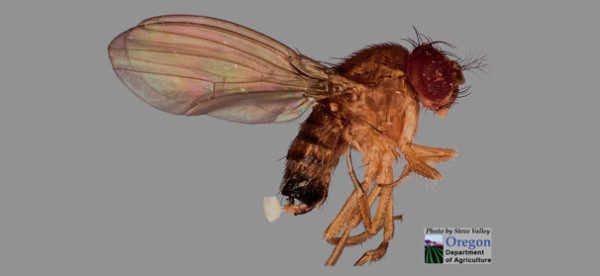

Nov 6, 2012SWD doing significant damage to berries
Spotted wing drosophila (SWD) hit Michigan hard in 2012. Worst off were fall red raspberry growers, who had to deal with wormy berries and customer complaints. Some decided to stop growing raspberries altogether, said Rufus Isaacs, an entomologist with Michigan State University (MSU).
SWD, an invasive pest of berries, stone fruit, grapes and other fruit crops, is native to Asia. Its first North American appearance was in California in 2008. Since then, it has spread to many of the primary fruit-growing regions of the United States. In Michigan, SWD was first detected in late 2010 in 13 counties, according to MSU.
Soft-skinned fruit like blueberries, raspberries and blackberries are at the greatest risk from SWD. Females have a serrated ovipositor, or egg-laying device, that cuts a slit into the skin of intact fruit to lay their eggs. That makes SWD a more significant pest than native vinegar flies, which require damaged fruit to lay eggs, according to MSU.
Bob Tritten, an MSU Extension educator in eastern Michigan, said blackberries, blueberries and day-neutral strawberries were damaged by SWD this year – the first year the pest has had a significant impact in Michigan. In his 34 years working in the state’s fruit industry, this is the fastest-growing invasive pest Tritten has seen.
“This is most definitely the worst year so far,” he said. “SWD is ramping up in terms of numbers.”
Many fall red raspberry growers were caught off guard by SWD. Some had to stop harvesting prematurely. Others worked their way through the problem by making extra applications of insecticide – which they weren’t used to doing during harvest. Some had to invest in the right equipment for harvest applications, such as airblast sprayers for better penetration. Some elected to stop growing raspberries altogether, Tritten said.
Strategies
SWD hit berries in the Northeast, too, said Nate Nourse, sales director for Nourse Farms, a berry farm and nursery based in Whately, Mass.
After a couple of years of experience with SWD in fall red raspberries, Nourse Farms has developed a strategy that can effectively manage the pest in its wholesale and u-pick fields. Soft enough to lay eggs in, raspberries are the first choice of SWD. The eggs are probably laid during pink stage, Nourse said.
If ripe berries are left alone for three or four days, the eggs start to hatch – and customers start noticing their berries are filled with worms. That’s why it’s important to strip the fruit off the canes as soon as it’s ripe. Nourse’s workers pick Monday, Wednesday, Friday and Saturday. The Saturday harvest helps ensure a clean, picked field that can be sprayed that evening or the next day, he said.
They spray between pickings every five to seven days, using 24-hour PHI materials – like Malathion, Mustang and Delegate – as much as possible. If the pickers do a good job, there are no ripe berries left in the field – and nowhere for SWD to hatch, Nourse said.
As long as they stay on the pick and spray schedule, the berries don’t see much damage, he said.
Nourse Farms harvests raspberries in summer and fall. Nourse tried to separate the two harvests by 14 days this year in order to “reset” the fields, but it ended up being about a seven-day gap, he said.
During the break, they pruned the summer raspberry plants, taking out the old canes that had fruit on them. They also pruned the edges of the fall raspberry plants, getting rid of the shorter primocanes. They sprayed insecticide with a five- to seven-day re-entry interval. All those actions can help clear fields for a week or so, which can deprive SWD of fruit and eliminate whatever larvae might be left in the field, Nourse said.
As for the farm’s u-pick berry fields, as soon as customers were done picking Nourse employees went through the rows and cleared whatever berries were left over. They would close down the field for a day in the middle of the week, allowing the application of 24-hour PHI material – then they would open it up for more picking the day after, he said.
Using traps helped Nourse gauge SWD numbers. The traps also revealed that the pest harbors near the tree line more than the open fields. It harbors in other crops, too, he said.
In Nourse’s opinion, the best traps include vinegar and yeast. Lots of growers use plastic or Styrofoam cups with lids, and melt a hole for the bugs to crawl into, where they get stuck.
SWD pressure got higher later in the season, but as long as they were vigilant, their strategies kept SWD eggs from hatching, he said.
“While we found larvae in both raspberries and blueberries, we had no complaints from our customers,” Nourse said.
Monitor SWD
Entomologist Rufus Isaacs and other MSU personnel recently put together a list of SWD management recommendations for Michigan’s raspberry and blackberry growers. There are six main steps:
1. Monitor fields with traps and check them regularly.
2. Check trapped flies to determine presence and number of male and female SWD.
3. If SWD is detected in traps, apply effective insecticides to protect the fruit.
4. Monitor to evaluate your management program; respond quickly if needed.
5. If possible, remove leftover fruit to reduce SWD breeding and food resources.
6. Stay informed; recommendations are subject to change. For the latest information, visit MSU’s SWD website.
By Matt Milkovich, Managing Editor














